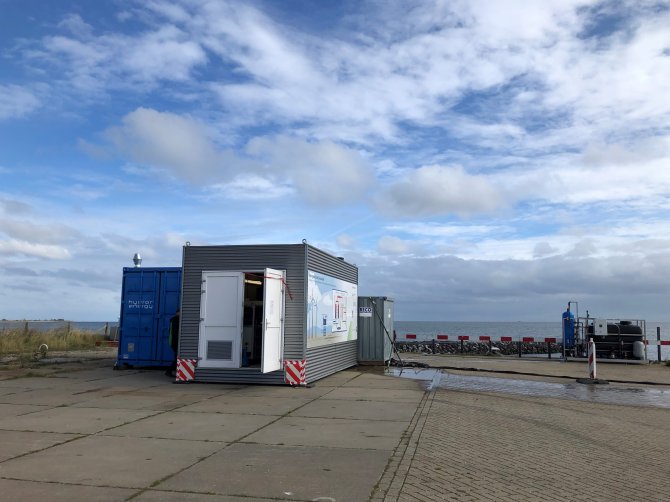
News
Green hydrogen at sea cheaper and more sustainable
Researchers from Wageningen University & Research have shown that the production costs of green hydrogen via electrolysis at sea can be reduced by making Ultra-Pure Water (UPW) on site by means of membrane distillation. This ultra-clean water is essential for the conversion of wind energy into 'green' hydrogen.
With this research, a demonstration prototype on Texel showed that ultra-pure water can be made from seawater with residual heat released during electrolysis of water (for hydrogen production). Jolanda van Medevoort, project leader of this research and researcher within the Water Treatment & Technology program is delighted that this pilot has been completed so successfully. “This makes the business case for green hydrogen more competitive and that is desperately needed, because at the moment green hydrogen cannot compete with grey hydrogen produced with fossil energy. And what is just as important is that the membrane distillation process itself is also more environmentally friendly compared to reverse osmosis, which is now often used. Membrane distillation not only uses much less electrical energy because it applies the residual heat from the electrolyzer, but it is also more environmentally friendly because no chemicals are needed for the pre-treatment of seawater. Also, the seawater hardly becomes saltier, in contrast to reverse osmosis (RO), which means that the underwater environment is not affected. And of course that no drinking water has to be used for this process.”
Ultra-Pure Water with Membrane Distillation
The process of membrane distillation to produce very clean water from seawater is not new in itself, because the process requires a lot of heat and therefore energy, it is not the best, economically feasible solution for all applications, but for this case it is. The heat produced by the Electrolyzer must be dissipated quickly for the electrolysis process to run smoothly. By using this heat for membrane distillation, cooling with seawater is no longer necessary and the required ultra-pure feed water for the electrolyzer is immediately produced. The costs of Ultra-Pure Water will be lower than, for example, the application of reverse osmosis (RO), which lowers the overall electrical efficiency of the entire hydrogen system. This is because reverse osmosis is an electrically driven process.
The main results within the project
The main result is the working proof of the technological principle by building a working membrane distillation system, integrating it with the electrolyzer and demonstrating the combined system on the dock of Seaport Texel.
The photo below shows the installations at the demo location. The electrolyzer and membrane distillation installations are both built into a container to be able to transport them to the demo location on Texel. The electrolyzer of project partner Hydron Energy in the blue container and in the grey/white adjacent the membrane distillation installation of Wageningen Food & Biobased Research. The seawater intake (Pump with sand filter) to pump the seawater directly to the membrane distillation installation is on the right corner of the dock. The Electrolyzer has produced the expected amount of hydrogen on the water produced by the membrane distillation. This water is produced by means of the residual heat given off by the electrolyzer.

An economic evaluation has shown that additional benefits can be gained from the amount of water produced with the residual heat. About a third of the water produced is used for hydrogen production. Two thirds of the water produced is available for other purposes. This is very pure water and is interesting in areas/periods with water scarcity, offshore, but also for drinking water or industrial applications.
Green hydrogen
"Green" hydrogen is an important part of the transition to a society free of fossil fuels. It can be used, among other things, as a fuel and as a chemical raw material for various industrial processes. In addition, it is an important solution for buffering sustainable energy at peak times of both wind and solar energy. At peak times, solar and wind energy is often free or customers are even paid for purchase to prevent overloading of the network.
At such moments, offshore wind energy can be converted into hydrogen. An additional advantage of producing hydrogen at sea is that the existing gas pipeline infrastructure can be used for transporting hydrogen to land, which is considerably cheaper than installing additional electricity lines to bring the wind energy ashore.
Next steps
The next phase is to demonstrate this concept on a larger scale (0.5-1 MW) at an offshore location with relevant partners. Potentially interesting partners for such a follow-up project are network and wind park operators, producers of membrane distillation and polymer electrolyte water membrane electrolysis and an offshore platform (demo location).